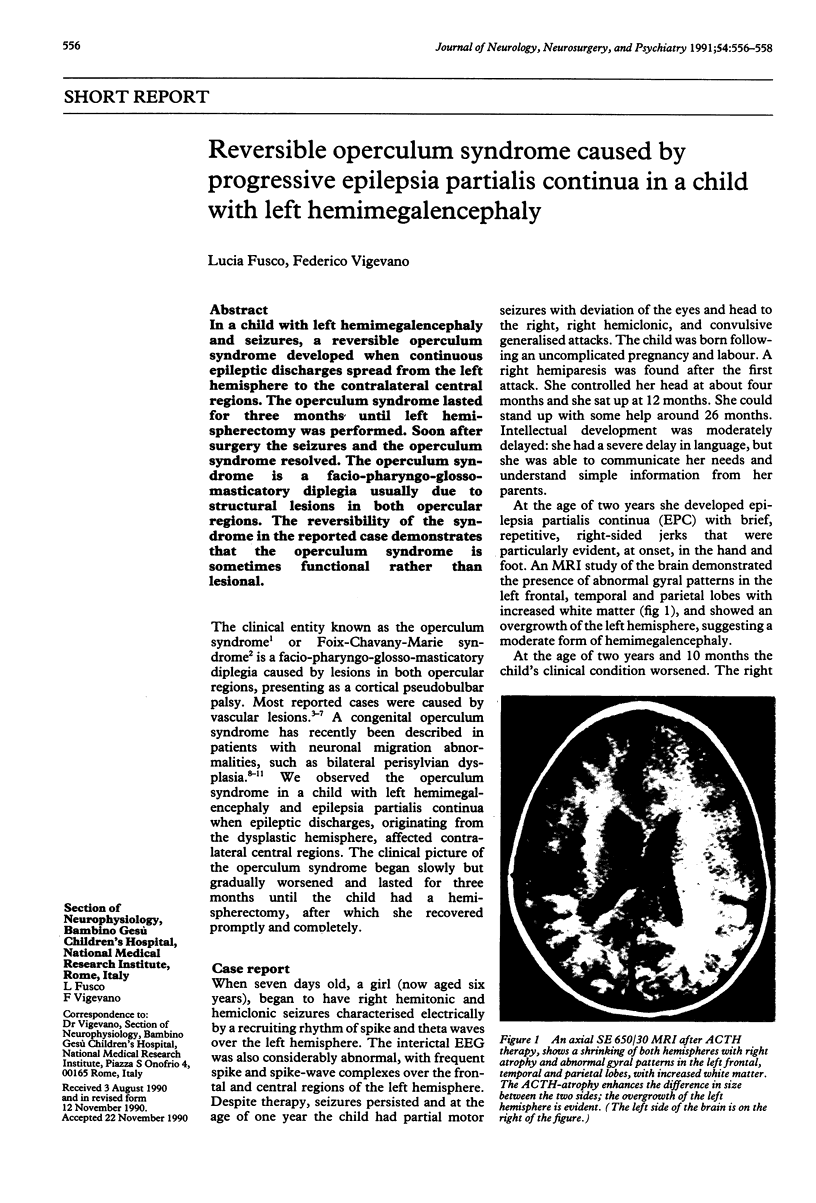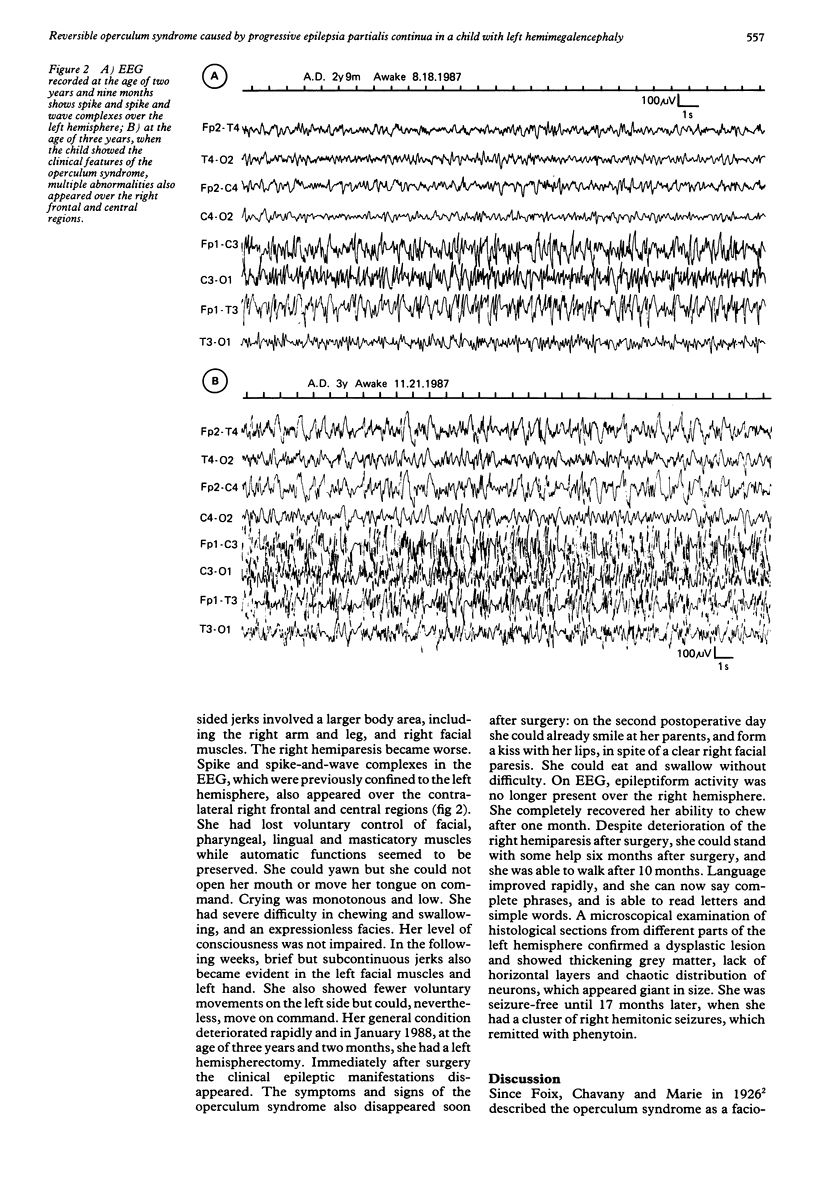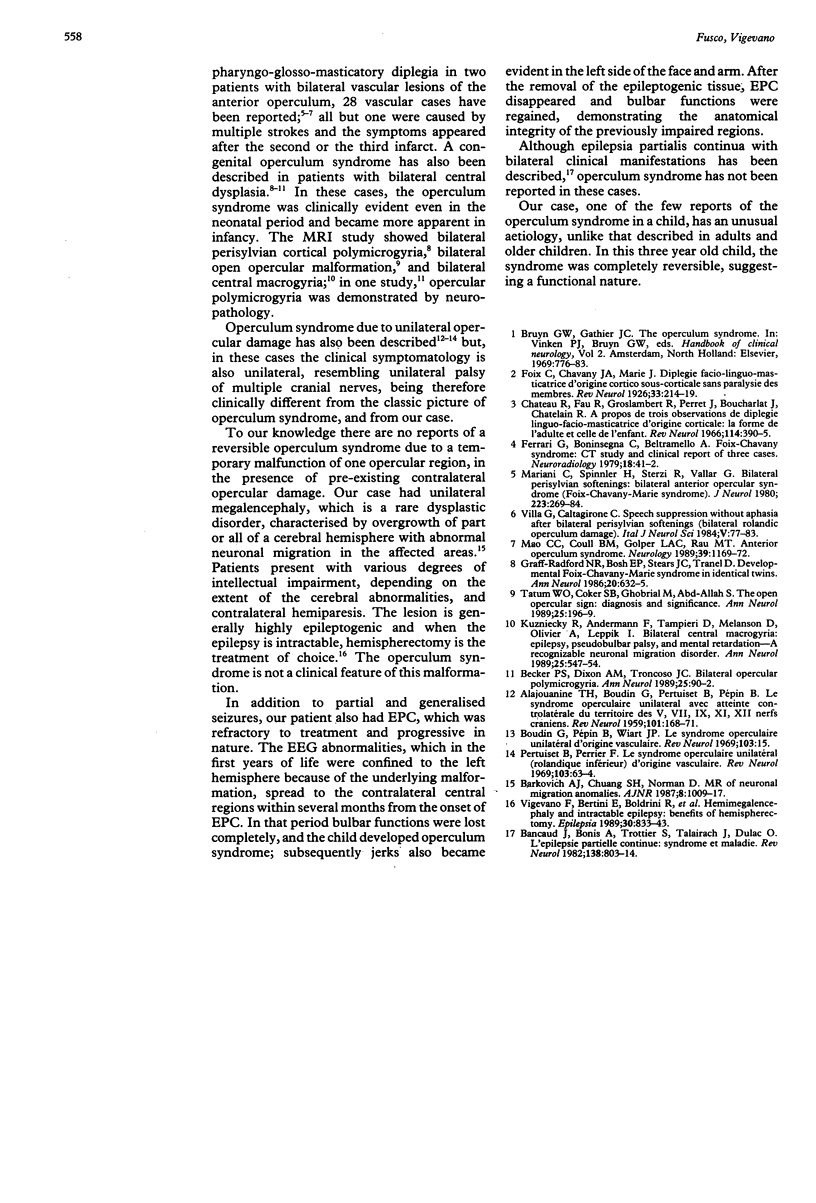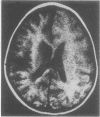Abstract
In a child with left hemimegalencephaly and seizures, a reversible operculum syndrome developed when continuous epileptic discharges spread from the left hemisphere to the contralateral central regions. The operculum syndrome lasted for three months until left hemispherectomy was performed. Soon after surgery the seizures and the operculum syndrome resolved. The operculum syndrome is a facio-pharyngo-glosso-masticatory diplegia usually due to structural lesions in both opercular regions. The reversibility of the syndrome in the reported case demonstrates that the operculum syndrome is sometimes functional rather than lesional.
Full text
PDF


Images in this article
Selected References
These references are in PubMed. This may not be the complete list of references from this article.
- Bancaud J., Bonis A., Trottier S., Talairach J., Dulac O. L'épilepsie partielle continue: syndrome et maladie. Rev Neurol (Paris) 1982;138(11):803–814. [PubMed] [Google Scholar]
- Becker P. S., Dixon A. M., Troncoso J. C. Bilateral opercular polymicrogyria. Ann Neurol. 1989 Jan;25(1):90–92. doi: 10.1002/ana.410250115. [DOI] [PubMed] [Google Scholar]
- Château R., Fau R., Groslambert R., Perret J., Boucharlat J., Châtelain R. A propos de trois observations de diplégie linguo-facio-masticatrice d'origine corticale: la forme de l'adulte et celle de l'enfant. Rev Neurol (Paris) 1966 May;114(5):390–395. [PubMed] [Google Scholar]
- Ferrari G., Boninsegna C., Beltramello A. Foix-Chavany syndrome: CT study and clinical report of three cases. Neuroradiology. 1979 Jul 1;18(1):41–42. doi: 10.1007/BF00346210. [DOI] [PubMed] [Google Scholar]
- Graff-Radford N. R., Bosch E. P., Stears J. C., Tranel D. Developmental Foix-Chavany-Marie syndrome in identical twins. Ann Neurol. 1986 Nov;20(5):632–635. doi: 10.1002/ana.410200513. [DOI] [PubMed] [Google Scholar]
- Kuzniecky R., Andermann F., Tampieri D., Melanson D., Olivier A., Leppik I. Bilateral central macrogyria: epilepsy, pseudobulbar palsy, and mental retardation--a recognizable neuronal migration disorder. Ann Neurol. 1989 Jun;25(6):547–554. doi: 10.1002/ana.410250604. [DOI] [PubMed] [Google Scholar]
- Mao C. C., Coull B. M., Golper L. A., Rau M. T. Anterior operculum syndrome. Neurology. 1989 Sep;39(9):1169–1172. doi: 10.1212/wnl.39.9.1169. [DOI] [PubMed] [Google Scholar]
- Mariani C., Spinnler H., Sterzi R., Vallar G. Bilateral perisylvian softenings: bilateral anterior opercular syndrome (Foix-Chavany-Marie syndrome). J Neurol. 1980;223(4):269–284. doi: 10.1007/BF00313341. [DOI] [PubMed] [Google Scholar]
- PERTUISET B., PERRIER F. [Unilateral opercular syndrome (inferior rolandic) of vascular origin]. Rev Neurol (Paris) 1960 Jul;103:63–64. [PubMed] [Google Scholar]
- Tatum W. O., Coker S. B., Ghobrial M., Abd-Allah S. The open opercular sign: diagnosis and significance. Ann Neurol. 1989 Feb;25(2):196–199. doi: 10.1002/ana.410250216. [DOI] [PubMed] [Google Scholar]
- Vigevano F., Bertini E., Boldrini R., Bosman C., Claps D., di Capua M., di Rocco C., Rossi G. F. Hemimegalencephaly and intractable epilepsy: benefits of hemispherectomy. Epilepsia. 1989 Nov-Dec;30(6):833–843. doi: 10.1111/j.1528-1157.1989.tb05347.x. [DOI] [PubMed] [Google Scholar]
- Villa G., Caltagirone C. Speech suppression without aphasia after bilateral perisylvian softenings (bilateral rolandic operculum damage). Ital J Neurol Sci. 1984 Mar;5(1):77–83. doi: 10.1007/BF02043975. [DOI] [PubMed] [Google Scholar]



